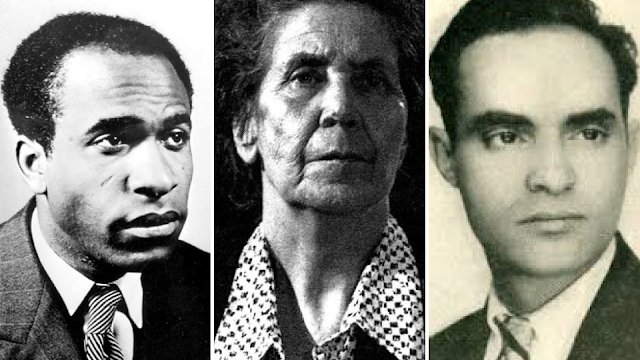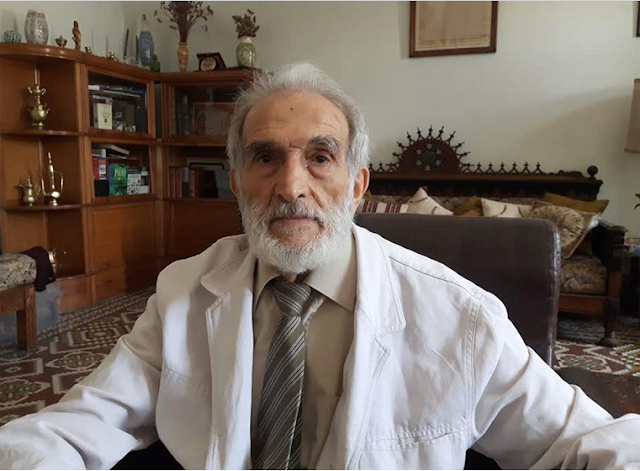The Luminaries Behind Our Hospital Names
The Luminaries Behind Our Hospital Names
Asma AIT SAID
HAMOUD LALIAM Nafissa
On the 17th of March 1924, the capital of the country witnessed the birth of a woman recognized today for her fervent patriotism, strength of character and remarkable path in the medical field.
Having lived her early years under the oppressive French colonization, Nafissa HAMOUD was fully devoted to lead her nation t o freedom and serv e it faithfully.
In 1944, she registered at the faculty of medicine in Algiers. Despite the complexity of medical studies, the young student was endowed with considerable energy and eagerness to be a part of various active organizations, at the head of them the NAMSA (North African Muslim Student’s Association), of which she became vice-president in 1947, and the AMWA (Algerian Muslim Women’s Association) which she had founded herself in the same year, strongly arming her in the fight for women’s rights and the support of African women’s liberation.
Soon after earning her doctorate in medicine, she specialized in gynecology and obstetrics and thus became the 2nd Algerian female doctor in the c olonial period.
Her drive and ambition to grow and broaden her medical horizons pushed her to open a private practice in the Lyre avenue back in 1953, which served as a secret shelter for the mar tyrs ABANE Ramdane, and Beny oucef BENKHEDDA. Being a member of private groups of the APP (The Algerian People’s Party) and having taken part in the widespread manifestations that occurred on the 8th of May 1945 proved her commitment by standing beside her compatriots in the war for liber ty.
Not long after the Algerian independence, she cooperated with her specialist colleagues to establish the first National Center of Birth Control in Mustapha Bacha hospital. Years later, in September 1st, 1974, she became Head of the Gynecology and Obstetrics Department of Parnet hospital in Hussein Dey, where she spent most of her life. The center became eponymous to our heroine after she passed away ‘’ The university hospital of Nafissa HAMOUD’’.
Frantz FANON, in full Frantz Omar FANON
Remarkably renowned and praised for the depth of his thoughts, the width of his knowledge and the exceptionality of his perspectives, Frantz FANON was extraordinarily brilliant in different fields namely social philosophy and psychiatry. The various concepts expressed in his books have had a strong impact on the minds of many generations of thinkers and philosophers.
Born on the 20th of July 1925, as a descendant of African slaves brought to the Caribbean island of Martinique, a French colony; FANON grew up amidst an environment governed by discrimination, oppression, corruption and domination; which fundamentally influenced his perception of the world and orientated his steps towards the flow fight f or national liberation o f colonized people. Shortly after taking part in World War II under the French flag, he joined the University of Lyon where he pursued his studies in medicine and psy chology.
In 1952, he arrived to Algeria and settled in Blida, a city revealed to be one of the biggest anti-colonist cities, ergo inflaming Fanon’s motive to join the National Liberation Front (FLN) and follow the outbreak of the Algerian revolution on No vember 1st, 1954.
Through his three years of practice in a psychiatric ward in Joinville Hospital in Blida, subsequently named after the legend; he became progressively more conscious of the concrete impact of the aggressiveness and brutality exercised by the unfair occupation on the psychological and mental state of the population. Many of his books bear witness to his critical opinions regarding the matter of colonization. We recall as his first major work ‘’ Black skin, white masks” (1952) that played a considerable role in awakening the world’s consciousness about the psychic, spiritual and the physical agony undergone by an endless number of colonies for years.
Another of his notable endeavors was helping create the Algerian newspaper ‘’El Moudjahid’’, writing in the same period as his second most successful classical book ‘’The Wretched of the Earth’’. Afterwards, he became the Ambassador of Algeria in Ghana.
In the most sorrowful circumstances, the great fighter left the world in November 16th, 1961 in Washington DC, after succumbing to Leukemia. He was later buried in the Algerian land in the ‘’ Martyrs’ Cemetery’’, according to his will.
Mohamed-Lamine DEBAGHINE
The authentic symbol of the Algerian revolution, a man with vigorous character and golden values, Al-Mujahid Mohamed- Lamine DEBAGHINE has always been glorified for having fought heart, body and soul to finally witness the Algerian flag fluttering freely.
Born on January 24th, 1917 in Cherchell, he grew up eager to receive a wide education in his mother tongue. Determined to be an effective member of the society, he joined medical school and had a successful path during which he became a member of the NAMSA (Nor th African Muslim Students Association) and eventually earned a Doct orate in medicine.
His tendency to be involved in politics drove him to join the PPA (Algerian People’s Party) in 1939, of which he remained an efficient representative while practicing his job as a doctor in his private practice which he had opened in 1944 in El Eulma – Sétif-. The veteran later joined the MTLD (Mo vement for the Triumph of Democratic Liber ties) and was sele cted in 1946, to be the deputy of the 2nd district -Constantine-.
Despite being strongly opposed to the fascism of the Dutch and Italian, he firmly refused, on principle, to fight against them for the French army in the Se cond World War. On August 20th 1947, at The French National Assembly, the MTLD’s deputies bravely reported the oppression and despotism of the colony. Blessed with great charisma, Mohamed Lamine DEBAGHINE strongly gave a sensational speech in which he fearlessly approved Algeria as an absolute Nation and heroically refused the interruptions of French minister several times by stating undeniable arguments based on historical facts while vehemently shouting for Algeria’s freedom.
After being arrested on Juin 24th, 1955 by the French colonial authorities and released six months later, he was made an associate of the FLN’s exterior delegation, a member of the CNRA (Algerian National Revolutionary Council) in Soummam Congress that took place in August 1956 and an important part of the CCE (Coordination and Execution Committee). The warrior was later selected as the First P rime Minister of the GPRA (Provisional Government of the Algerian Republic) in 1958. Soon after Algeria’s independence, he withdrew himself from politics and carried on his medical profession at his private practice.
Following a brain stoke, death reclaimed our hero at the age of 86 in the bitter day of January 20th 2003 and was buried in a cemetery in Sidi M’hamed- Algiers. His name is still engraved on top of the portals of Beb El-Oued’s hospital, formerly known as Maillot’s military hospital.
"N’oubliez pas, Mesdames et Messieurs, l’Algérie est une Nation. Elle a été une Nation et a été souveraine. Seule l’agression de 1830 lui a fait perdre sa souveraineté. On a trop tendance à l’oublier! "Discours de Mohamed-Lamine DEBAGHINE en 1947 devant le parlement français.
Pierre and Marie CURIE
Having dedicated their lives to physics, were both honored alongside with a Nobel Prize and together brought to existence luminous children such as themselves, the legendary couple Pierre and Marie Curie are universally renowned for having made a considerable contribution to the progress of science and represent therefore a great source of inspiration for many generations.
Way before their marriage, Pierre and Marie CURIE grew up in two different lands yet shared the same ambitions and be came pioneers of radioactivity.
Marie CURIE, born Maria Salomea Skłodowska, in Warsaw, Poland on the 7th of November 1867, faced a lot of struggles to become the successful scientist she had always aspired to be. Having been deprived of graduate education like all of the girls of her homeland, the ambitious young student was compelled to work as a governess to earn the money that allowed her to move to Paris and register in the Sorbonne University where she obtained two degrees in both physics and mathematics, and where destiny united her with her c olleague and future husband Pierre.
Having gone through financial problems himself, the French physicist had to work as a laboratory instructor in order to finish his research at the faculty and eventually obtained his diploma in physics 1878 and started working at the laboratory of physics jointly with his brother Jacques on Piezoelectricity and Crystallography where he discovered on his own ‘’Curie Point’’.
Hypnotized by the brilliance and determination of the Polish physicist, Pierre CURIE decided to end his work on Piezoelectricity and Crystallography and dedicated his research in collaboration with Marie C urie. A par tnership that led t o the discovery of radium and polonium. Together, despite the arduousness of the conditions under which they had to work, the couple retained their motivation to finish the work of the French physicist Henri Becquerel on the spontaneous radiation and were afterwards awarded a Nobel Prize in physics in 1903, shared with Becquerel. Three years later, soon after the death of her husband, Marie became the first f emale professor at the Sorbonne.
In 1910, she proved the undeniable existence of Radium as a pure metal and was honored a year later with a se cond Nobel Prize in Chemistry. She was henc e recognized as the one and only woman to be in the list of the Magnificent Four who received Double Nobel and the second intellect after Pauling whose two Nobel Prizes are in different fields. Following her parent’s footsteps, Irène JOLIOT CURIE worked together with her mother to provide mobile X-ray units during World War I. After the war, Irène worked in collaboration with her husband Frédéric JOLIOT in her parent’s institute and w ere both awarded a Nobel P rize years later.
Two leading figures internationally acknowledged, Pierre and Marie CURIE have many universities, libraries, avenues and even banknotes, named after them. In Algeria, the oncology department in Mustapha P acha hospital carries their names (C entre Pierre et Marie CURIE).
"It would be a beautiful thing though, a thing I dare not hope, if we could spend our lives near each other, hypnotized by our dreams: your patriotic dream, our humanitarian dream and our scientific dream." Pierre Curie in his letter to Maria Skłodowska- August 10, 1894.







Commentaires
Enregistrer un commentaire